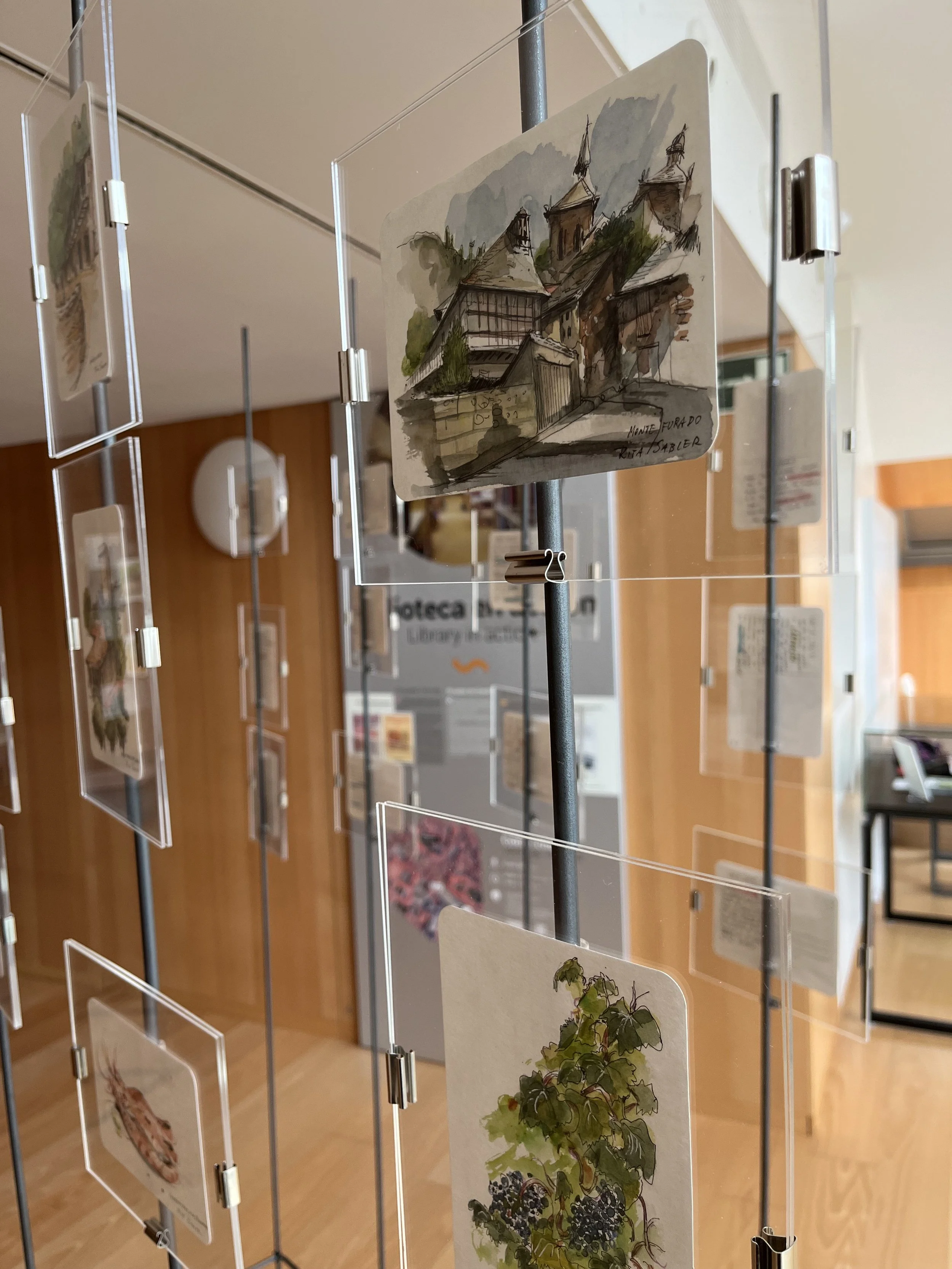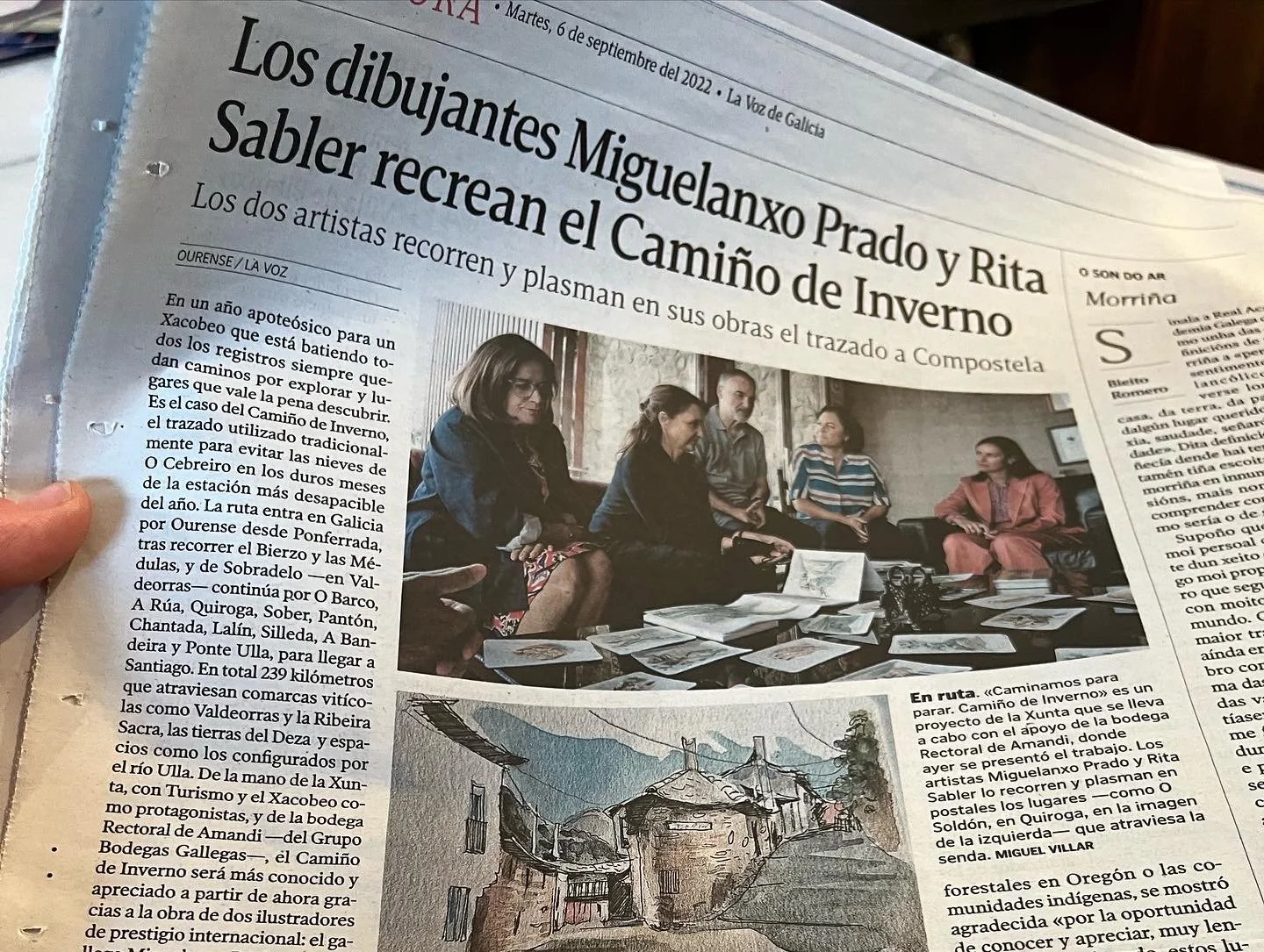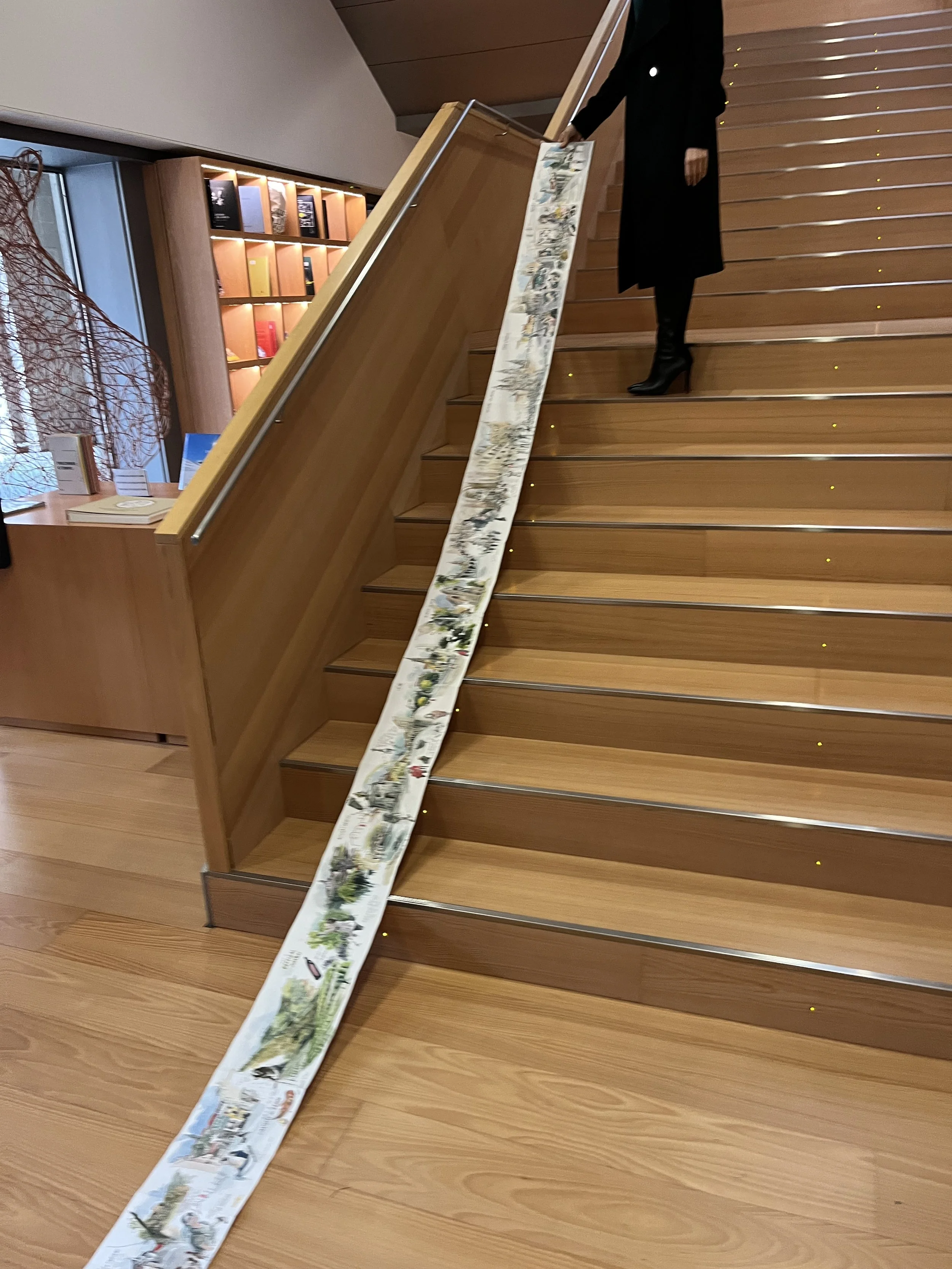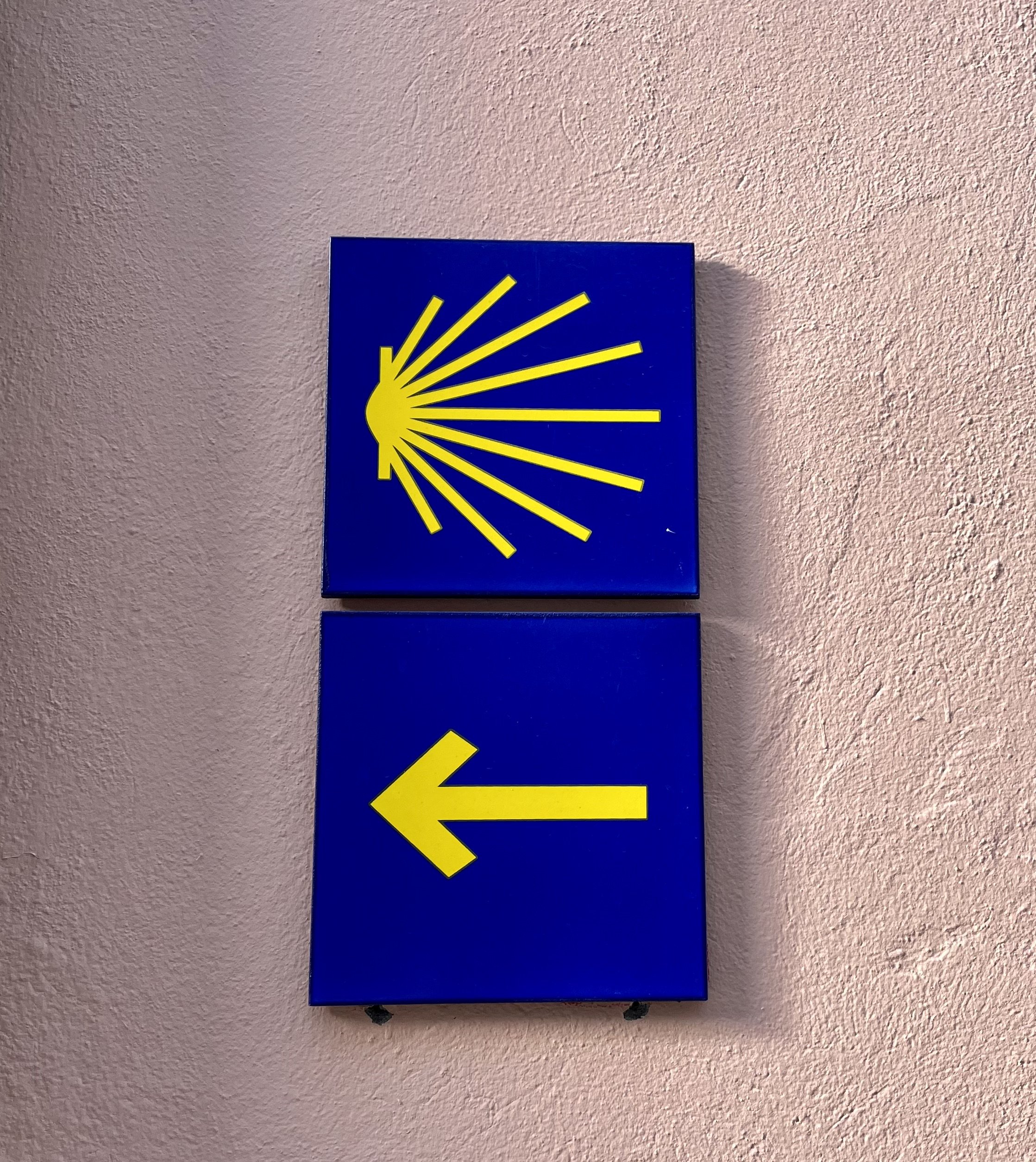
Walking and Drawing Camino de Santiago
Standing on the shore of the river Síl in the town of O Barco de Valdeorras in Galicia, Spain I looked at the hillside scorched by recent wildfires, reflecting on the summer forest fires that were plaguing my home in the Pacific Northwest of the United States. I was at the starting point of the Camino de Santiago pilgrimage, a project commissioned by Compostela Ilustrada with the help from Turismo de Galicia.
Camino de Santiago is an ancient route that pilgrims walked for centuries in hopes to have their sins pardoned upon the arrival to the final destination—the ornate Cathedral of Santiago de Compostela. In modern times the walk is done mostly for purposes of tourism, to celebrate life’s milestones, or simply as a physical challenge.
The idea of the project “ Camiñar para Parar” or “Walk to Stop” is to take in the sights slowly and with intention. For myself and my counterpart, Galician artist Migualntxo Prado, it also meant leaving a trace of illustrated vignettes of this journey. For 10 days and 184 kilometers we were drawing and walking side by side. Our drawing styles and philosophies are different, but we quickly came to enjoy each other’s sense of humor and shared a lot of great laughs and stories along the way. Together with our fearless producer Gemma Sesar, videographer/driver Serginho and our support team we walked, sketched, shared meals, and searched our next stop on the map.
As I look through the 40 postcard drawings that I made during the Walk and through my accordion style 5 meter long sketchbook that I completed as a personal challenge, all of the memories come rushing back. Drawings have this power to put you right back into the moment, stirring all of the senses, not just the visual cortex. I can still hear the barking of the dogs who greeted us along the way from the fenced properties. I could feel the sweet taste of grapes that we would snack on walking through multiple vineyards along the way. The grape grown in this region is called Mencia. It makes for delicious full bodied wine that would accompany most of our meals. I hear the sound of the mighty bell startling us from the red stoned facade of the Tiny Iglesia de San Marino de Viloira in O Barco. I remember the warm coziness offered by “gallerias,” the typical ornate covered balconies designed as extra protection from the wind to the residents of Galician towns. I feel the stinging bites of hundreds of ants on my legs–I was almost eaten alive as I sketched from Ponte Vella, an old foot bridge over Minho river with the town of Petin above it. At that point the rest of the team wandered deeper into the mostly deserted town as I was trying to use the last remaining minutes of the quickly vanishing daylight.
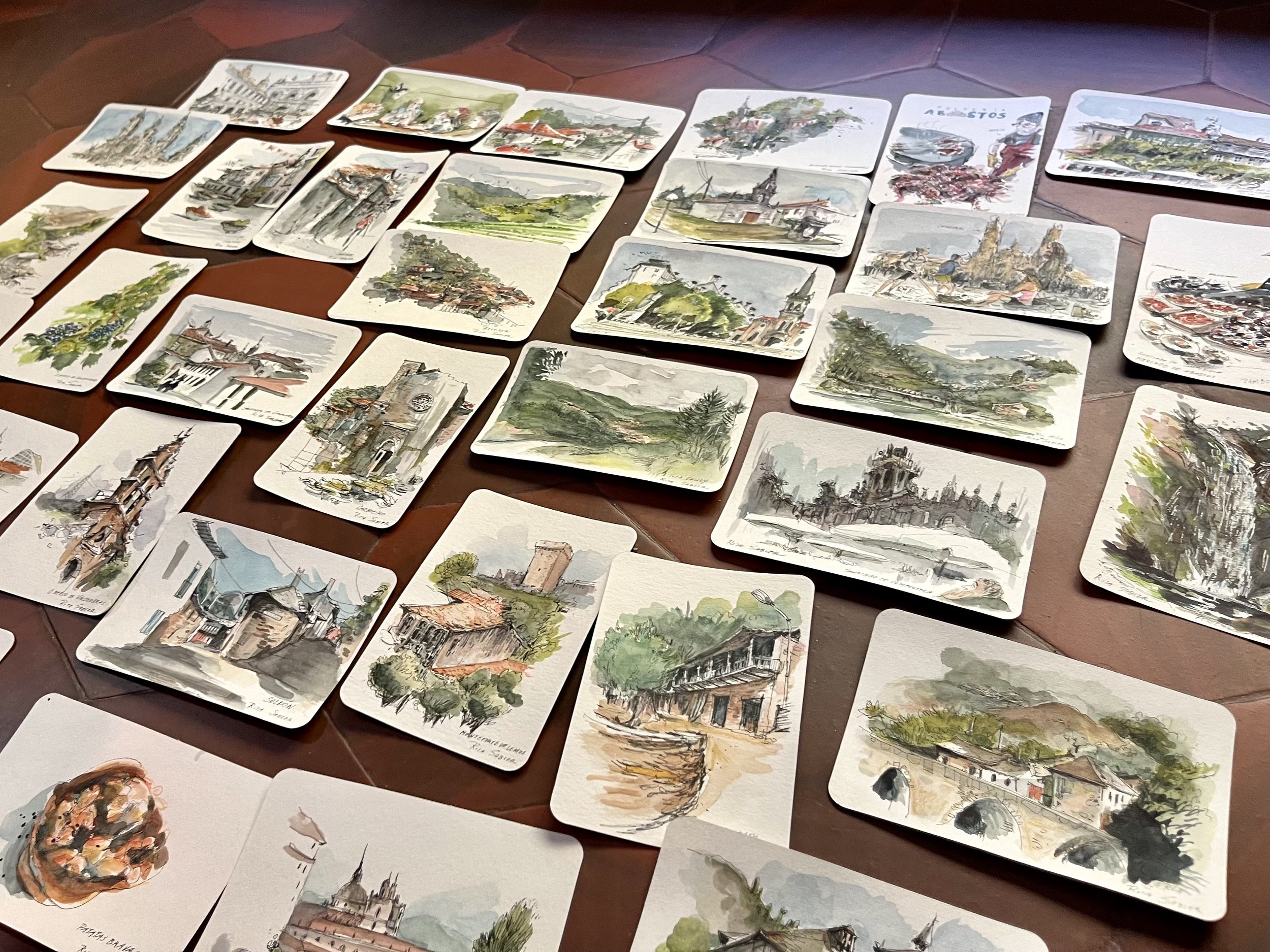
40 postcard drawings commissioned by Compostela Ilustrada
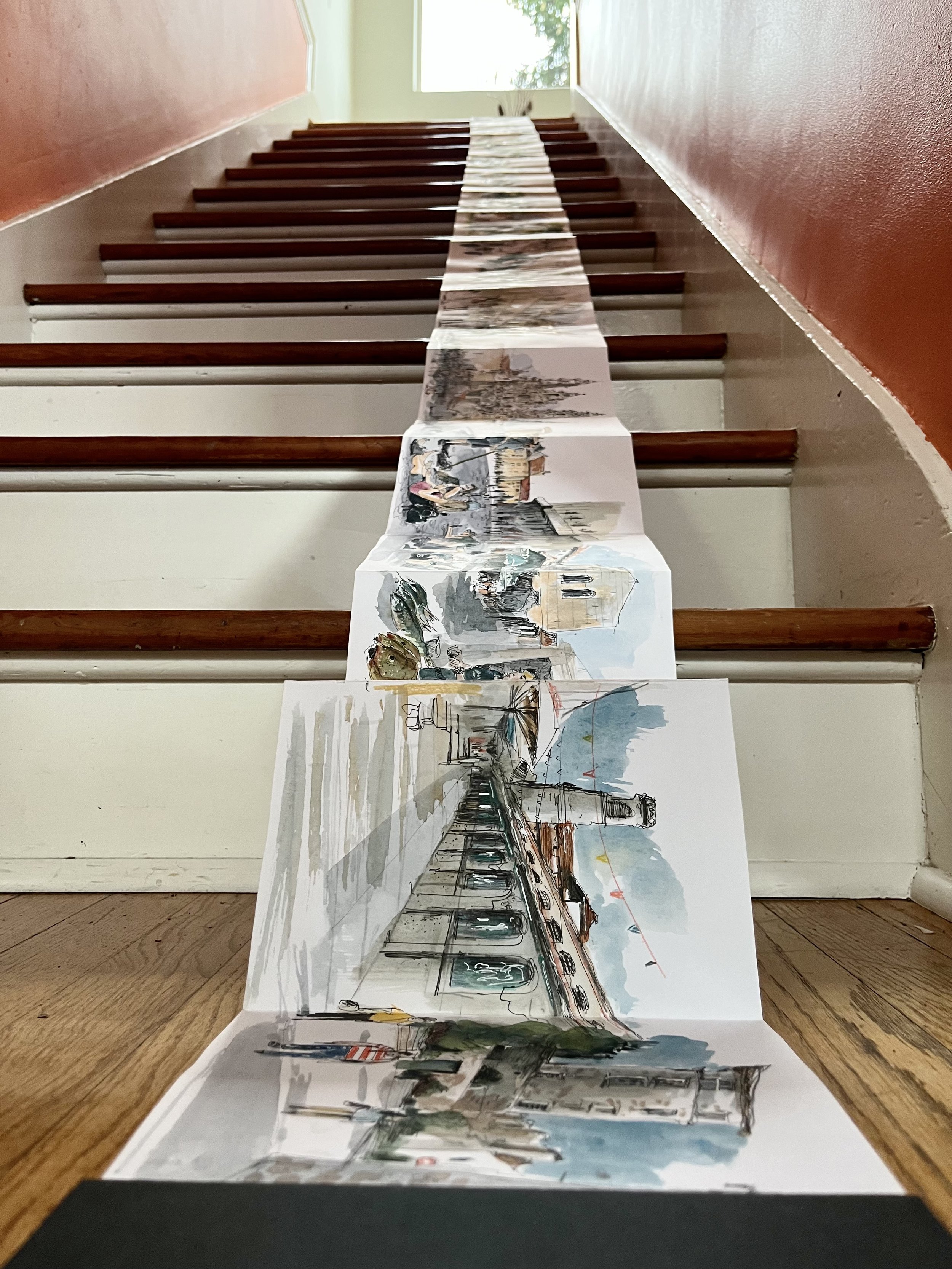
Accordion style 5 meter long sketchbook

Rectoral de Amandi vineyard
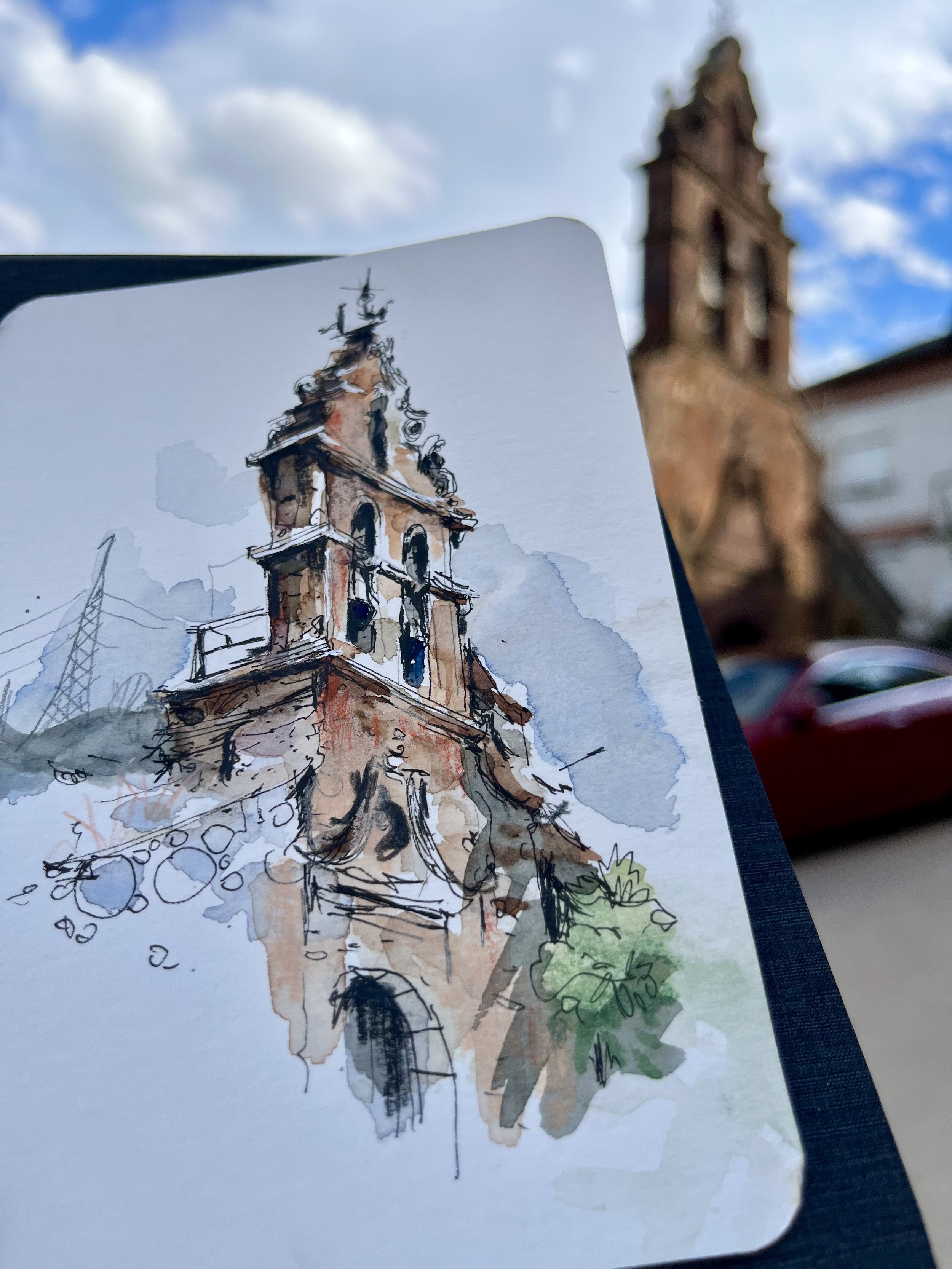
Iglesia de San Marino de Viloira in O Barco

Typical ornate covered balconies called "gallerias"

Ponte Vella, an old foot bridge over Minho river
During meal times at rustic diners I continued to draw Gallegos bonding over wine, cured meats, and giant piles of white bread. A group of scruffy looking men in a bar proudly declaring “Somos una Peña!” “We are buddies!” An older gentleman presiding over a traditional dark wooden table, surrounded by 6 Galician signoras with giant poofy hairdos, all ceremoniously chewing on their steaks in the town of Chantada.
Some days we would spend too much time drawing and wouldn’t be able to get to our destination by nightfall. Serginho would pick us up in a van and give us a little engine powered boost. Other times we would get taken by scenery and get a little off track, inadvertently adding a few kilometers to our daily “etapa”. Getting lost on the Camino is almost impossible — it is so well marked through various turns and twists with the bright yellow arrows on blue background and a little yellow shell, the emblem of the Pilgrimage.
One of the favorite parts of the walk was crossing the border from Ourense into Lugo provinces. The very first pueblo in Lugo– Os Alvaredos greeted us with colorful wooden artifacts attached to the walls of the weathered wooden houses. There was a special refueling station for the pilgrims—with coffee and fresh fruit. I would have happily spent a few hours here sketching but since we were just starting our day of walking we plowed ahead. Most of these villages feel almost deserted, with a few older residents, chickens, and dogs keeping guard. As we left Os Alvaredos we walked through a fragrant pine grove and an orchard of silvery olive trees.
An older gentleman surrounded by 6 Galician signoras
Typical signs showing pilgrims which way to go
The town of Montefurado
Main Square in Lalín
On the Day 4 of the Camino walking from Quiroga to Monforte de Lemos I started chatting with a pilgrim named Juan from the La Mancha region. I nicknamed him “Don Quixote” . He walked the Camino de Santiago at least 15 times. He said that the reason that pushes him to walk is the desire to get to know his own land. As we walked together for at least an hour he lamented the commercialization of the Camino and the loss of the spirit of offering pilgrims kindness and generosity as they make their way to Santiago.
I remembered seeing a few boxes of fruit and treats for the pilgrims on the way and reflected on how these walkers who often had nothing but a shell that served as a small cup and a makeshift knife completely depended on the kindness of strangers.
Retired now, Juan told me his career as a nurse at the Children's hospital in Madrid started with treating patients with Toxic oil syndrome, an epidemic of poisoning by illegally sold cooking oil that affected about 20,000 people in Spain in the 1980s. He had to weigh sick kids that were brought to his hospital. Some were already so sick that they died as he moved them from a bed to a scale. That experience undoubtedly affected him in a very profound way and possibly made him such a devoted pilgrim.
Don Juan de La Mancha
Town of Belesar
Monasterio de Carboeiro
The last etapa with a visit to Ferveza do Toxa
The morning of Day 6 started off on a rainy note. We stopped over in the picturesque town of Belesar. There was so much to draw, but the stubborn rain kept us clinging for cover. When the rain stopped I walked over the old bridge to sketch a typical church bell tower.
In the afternoon the whole crew took a boat ride down the Miño river which allowed for some magnificent views of this area that is called Riberira Sacra, formed by the flow of three rivers that we saw during the walk–Miño, Sil and Cabe.
On Day 7, despite the challenge of climbing to the altitude of 1,100 m in the rain, I was determined to do the entire etapa Chantada to Lalin by foot. The Sanctuary of Nossa Senhora do Faro is the high point of the hike from which you can see all four Galician provinces. The rain was particularly stubborn that day. Three changes of clothes later I was finally almost to the top when the team picked me up in the van.
They told me that because of the fog and the rain up at the very top it was impossible to see your own feet, much less the four provinces. Yet, the endorphin rush and the spectacular scenery of that hike was well worth it.
Day 8 marked the path from Lalín to Santiago and brought us to the culmination point of the pilgrimage– the Cathedral in the city of Santiago de Compostela. But before we arrived at our final destination we hiked to check out the spectacular waterfall Ferveza do Toxa through the aromatic eucalyptus forest in the morning. The light of the rising son gently sipping through the dense morning fog was magical, so was the stop at the 10th century Monasterio de Carboeiro.
Belesar, Ferveza do Toxa, Carboeiro
As I arrived at the vast Obradoiro plaza in Santiago I was struck by several things at once. The west facing facade of the cathedral appeared to glow in the rays of the setting sun, as if promising eternal salvation to all the pilgrims who completed their arduous journey. Hundreds of modern day pilgrims were resting on the bare cool cobblestones of the square. As I surveyed the crowd of tired people I tried to guess if anyone there came to seek eternal salvation. There were a lot of outdoorsy types equipped with the latest athletic gear. Many took off their shoes exposing multiple blisters and calluses.
I noticed a man on his knees and elbows on the ground bowing toward the cathedral. At last, I thought, a pious type, repenting for his sins. Once I got closer, however, I realized that he was just trying to get a better photo with his phone.
As an artist I was capturing the Galician scenery and baroque facades but as a journalist I was deeply curious to talk to and learn about the modern day pilgrims and what motivated them to do the walk. A group of women said they wanted to celebrate turning 50 with their girl-friends. A young couple said they had been wanting to do it for a personal challenge. There were groups on bikes in matching spandex outfits. There were more classic pilgrim types brandishing shells with red crosses and old style wooden walking sticks.
Inside the cathedral the ritual called botafumeiro took place in honor of the arriving pilgrims. A giant brass urn of burning incense was swung overhead, precariously swaying over people gathered here for the mass. This ritual likely had to do with the fact that pilgrims often arrived sick and unclean. So botafumeiro became a way to perfume and clean the air.
Standing in the crowded nave of the cathedral I started drawing the mass that felt joyous and almost goofy thanks to the swinging urn. My giant accordion sketchbook decided to slip out of my hands and drop on the floor with a loud thump attracting some curious glances. Once again the sketchbook had a life of its own. As it often happened during the trip it would inflate like a parachute with the wind or clumsily drop into a puddle. Yet it weathered everything, even someone accidentally walking on its open pages in the museum.
On my second day in Santiago I spent the morning exploring the historic Mercado de Abastos in preparation for the workshops I would be teaching here in November. There are so many varieties of seafood in Galicia. Some of it looks so weird that it should belong in a museum of alien life, not a food market. Of course I had to sketch the eight legged king of Galician cuisine— el Pulpo Gallego. Vendors at the market were just as interesting as the fresh catch they were selling.
A few hours before I was scheduled to go back home I put all of the postcards I made during the Camino in a little metal tin box in order to hand them over to the producer Gemma. It was hard to part with these originals, but I knew I would have a chance to see them again in exactly one month at the Pilgrimage museum in Santiago de Compostela. The inauguration of the exhibit was scheduled for November 3, 2022.
The culmination of the Pilgrimage
Maria preparing Pulpo Gallego at the Mercado de Abastos
Modern day Pilgrims
Botafumeiro
